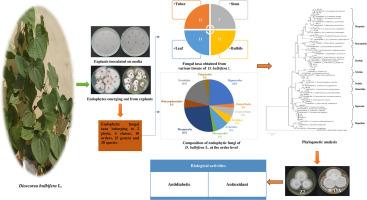从多样性、抗糖尿病和抗氧化活性角度深入研究球茎薯蓣的可培养真菌内生菌
IF 4.6
Q2 MATERIALS SCIENCE, BIOMATERIALS
引用次数: 0
摘要
内生菌研究的重点是了解复杂的微生物群组成、它们与寄主植物的相互作用及其生物活性潜力。我们的研究概述了与球茎薯蓣内生真菌相关的可培养内生真菌的多样性、分布和生物活性。分离出的真菌内生菌属于 25 属 38 种。此外,多样性指数表明,真菌内生菌在不同组织(茎、叶、块茎和球茎)中具有显著的多样性。使用香农指数发现,球茎中内生真菌分离物的一致性较高。此外,辛普森指数显示,叶组织中的真菌内生菌高度多样化。同样,Margalef 指数也表明球茎中的分类丰富度很高。本研究中分离出的 Acrocalymma medicaginis、Curvularia lycoperscii、Talaromyces macrospora、Fusarium laceratum、Paecilomyces formosus 和 Microascus cirrosus 等内生真菌是首次从任何植物中分离出来。乙酸乙酯提取物的体外抗氧化和抗糖尿病活性表明,Nigrospora oryzae(Z2)能有效抑制α-葡萄糖苷酶的活性,其 IC50 值为 0.6 µg/ml,而阳性对照阿卡波糖的 IC50 值为 0.040 µg/ml。抗氧化活性结果表明,H15A(Acrocalymma medicaginis)和 BD5(Phomopsis longicolla)可用作潜在的抗氧化剂来源。此外,据报道,H15A(Acrocalymma medicaginis)可产生 687.1 ± 0.17 µg GAE/mg的TPC和78.55 ± 0.29 µg QE/mg的TFC。这些发现表明,可以通过系统的生物指导研究来探索潜在的内生菌,从而进一步发现新型天然产物。我们的研究为深入了解内生菌与植物在分子和遗传水平上的相互作用提供了重要资源。本文章由计算机程序翻译,如有差异,请以英文原文为准。

Insights into the culturable fungal endophytes of Dioscorea bulbifera L. in terms of their diversity, antidiabetic and antioxidant activity
The research on endophytes is focused on understanding the complex microbiome compositions, their interactions with host plants and their bioactive potential. Our study provided an overview of the diversity, distribution and bioactivities of culturable endophytic fungi associated with fungal endophytes of Dioscorea bulbifera L. The phylogenetic analysis depicted the evolutionary relationship among taxa of endophytic fungal isolates. The isolated fungal endophytes belonged to twenty-five genera and thirty-eight species. Further, diversity indices demonstrated significant diversity of fungal endophytes in the different tissues: stem, leaf, tuber and bulbil. A higher consistency of endophytic fungal isolates in the bulbils was found using Shannon index. Furthermore, Simpson's index revealed that the leaf tissue harboured highly diverse fungal endophytes. Likewise, Margalef's index depicted high taxonomic richness in bulbils. The isolates such as Acrocalymma medicaginis, Curvularia lycoperscii, Talaromyces macrospora, Fusarium laceratum, Paecilomyces formosus and Microascus cirrosus isolated in this study have been reported as endophytes for the first time from any plant. In-vitro antioxidant and antidiabetic activities of the ethyl acetate extracts revealed that Nigrospora oryzae (Z2) effectively inhibited α-glucosidase activity with IC50 value of 0.6 µg/ml whereas IC50 value of the acarbose, the positive control was reported to be 0.040 µg/ml. The results of antioxidant activity demonstrated that H15A (Acrocalymma medicaginis) and BD5 (Phomopsis longicolla) could be used as potential sources of antioxidant agents. Moreover, H15A (Acrocalymma medicaginis) was reported to produce 687.1 ± 0.17 µg GAE/mg of TPC and 78.55 ± 0.29 µg QE/mg of TFC quantitatively. These findings suggest that the potential endophytes could be explored using systematic bio-guided investigations to further discover novel natural products. Our study provides an important resource for a deeper understanding of endophyte-plant interactions at molecular and genetic levels.
求助全文
通过发布文献求助,成功后即可免费获取论文全文。
去求助

 求助内容:
求助内容: 应助结果提醒方式:
应助结果提醒方式:


